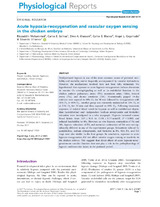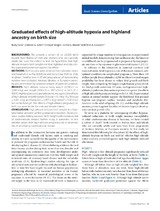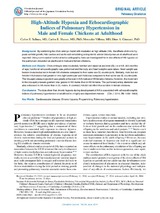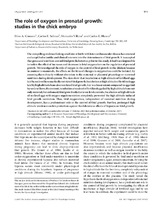Listar Producción científica por autor "Giussani, Dino A"
Mostrando ítems 1-5 de 5
-
Acute hypoxia-reoxygenation and vascular oxygen sensing in the chicken embryo
Mohammed, Riazuddin; Salinas, Carlos E; Giussani, Dino A; Blanco, Carlos E; Cogolludo, Ángel L; Villamor, Eduardo (Physiological Reports, 2017)Abstract. Fetal/perinatal hypoxia is one of the most common causes of perinatal morbidity and mortality and is frequently accompannied by vascular dysfunction. However, the mechanisms involved have not been fully delineated. ... -
Adrenocortical suppression in highland chick embryos is restored during incubation at sea level
Salinas Salmón, Carlos E; Villena, Mercedes; Blanco, Carlos E; Giussani, Dino A (High Altitude Medicine & Biology, 2011)Abstract. By combining the chick embryo model with incubation at high altitude, this study tested the hypothesis that development at high altitude is related to a fetal origin of adrenocortical but not adrenomedullary ... -
Graduated effects of high-altitude hypoxia and highland ancestry on birth size
Soria, Rudy; Julian, Colleen Glyde; Vargas, Enrique; Moore, Lorna G; Giussani, Dino A (Pediatric Research, 2013-10-02)Background: We present a cohort of ca. 25,000 birth records from Bolivia of men and women who are currently adults. We used this cohort to test the hypothesis that high altitude reduces birth weight and that highland ... -
High-altitude hypoxia and echocardiographic indices of pulmonary hypertension in male and female chickens at adulthood
Salinas Salmón, Carlos E; Blanco, Carlos E; Villena, Mercedes; Giussani, Dino A (Circulation Journal, 2014-06)Background: By combining the chick embryo model with incubation at high altitude (HA), the effects of chronic hypoxia on fetal growth, fetal cardiac and aortic wall remodeling and systemic arterial blood pressure at adulthood ... -
The role of oxygen in prenatal growth : studies in the chick embryo
Giussani, Dino A; Salinas Salmón, Carlos E; Villena, Mercedes; Blanco, Carlos E (J Physiol, 2007-10-25)The compelling evidence linking small size at birth with later cardiovascular disease has renewed and amplified scientific and clinical interests into the determinants of fetal growth. It is accepted that genes and ...





